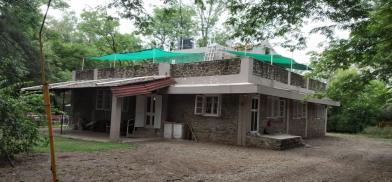In stay-at-home time, a low-cost air-conditioning system that needs no electricity
In these times of the COVID-19 pandemic when the air pollution and temperatures in the cities are increasing and more and more people and families are forced to stay inside their homes during the lockdown, they need to have a comfortable stay, especially in hot summer months

In these times of the COVID-19 pandemic when the air pollution and temperatures in the cities are increasing and more and more people and families are forced to stay inside their homes during the lockdown, they need to have a comfortable stay, especially in hot summer months. I would like to share our small experiment of developing a very economical and efficacious air-conditioning system for households that does not require any electricity.
I stay in the rural town of Phaltan in western Maharashtra. Phaltan is about 100 km southeast of Pune. Phaltan weather is mild but in April/May, the air is dry, and the temperature can reach up to 45 degree Celsius.
For the last 37 years, I have been living in a passively air-conditioned house (uses no electricity). I designed and built the house and its cooling system in 1984.
The house has 16 inches thick stone walls and, on the roof, we have put a green shade net on a simple angle frame to stop the sun from heating the roof surface. The roof surface is covered with discarded jute gunny sacks which are sprinkled with water once a day; around 2 p.m.
This simple system cools the house very nicely. The evaporating water from the soaked gunny sacks cools the roof and the ceiling fan inside the room brings down the cool air. Around 80 percent of the heat into the house comes from the roof. So a cool roof can easily bring down the temperature inside the room and make the living space very comfortable.
The green shade net stops the direct sunlight from heating the gunny sacks. So together with evaporating water, they remain cool throughout the day and night. This coolness is conducted through the roof to make the room cool.
We also close the windows and draw the curtains in the morning so that the radiative heat and glare do not come inside the room. The trees surrounding the house also reduce the heat. The 16” thick walls provide a thermal lag of about 10-12 hours and thus allow the heat to come inside the house through the walls only late at night. At that time with windows open, the outside cool night air can dissipate this heat rapidly.
Thus when the outside daytime temperatures have been 40-45 degrees celsius, our house has remained cool with inside temperatures of 28-30 degrees Celsius and under The ceiling fan can sometimes feel chilly.
This simple rooftop cooling mechanism is a highly effective air-conditioning system with little energy and monetary costs involved. The gunnysacks (costing Rs. 10/m2), last for about two years after which they need to be replaced. This is because the evaporating water leaves the salts behind which rot the jute sacks. The water requirement is only 1.5 liters per m2 of the roof.
Costing done by us has shown that this system cost one-tenth that of a regular electric AC system. Besides, when the electricity supply is erratic, especially during summer months, the rooftop evaporative system provides a very cost-effective and passive method of cooling the house. In addition, the capital cost of this system including the shade net and gunny sacks is only Rs. 250/m2.
This system can also work nicely in existing houses which have thin brick walls since 80 percent of the total heat input comes from the roof only.
Generally in dry hot regions, the ubiquitous desert evaporative coolers are used. These coolers work on the principle of water evaporation for cooling air. However, they increase the humidity inside the house which sometimes is not comfortable. With a roof cooling system, the inside humidity is not increased.
It should, however, be pointed out that this system works best in areas that have dry summers. With high humidity conditions, the roof evaporation will be less and hence there will be less cooling.
We also use this system in our offices and lots of people have copied this simple technique for their house and office.
(The writer, an IIT-trained mechanical engineer, is Director and Hon. Secretary, Nimbkar Agricultural Research Institute, Phaltan, Maharashtra. Views are personal. He can be contacted at anilrajvanshi50@gmail.com)









Post a Comment